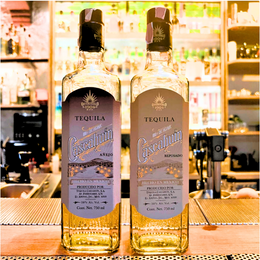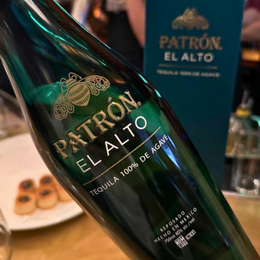Don Julio, the tequila brand's namesake, was one of the first tequila-makers to take agriculture and terroir seriously in the realm of agave plant-growing. He was also a pioneer of the añejo tequila style.

Last month, I headed down to Chimichanga Little India. I’ve been a big fan of Mexican food, which is why I’m familiar with the Chimichanga brand since my junior college/high school days. Their Little India branch offers Mexican drinks and dishes with a quirky Singaporean-Indian twist. There’s also a great mezcal collection here, and I was recommended to taste their premium agave spirit flight, which included the premium Don Julio 1942.



Chimichanga's Little India outlet has a rather accessible menu of tequila or mezcal flights at a very affordable price. It's well worth looking into this if you've been exploring agave spirits.
Don Julio is considered by many to be one of the first premium tequila brands, and much of its renown really comes from its visionary founder Julio González-Frausto Estrada (who later became the Don we hear about).

Amongst the earliest to begin producing añejo tequila, that is, aged tequila (between 1-3 years in oak), it is said that Don Julio would tuck away his best tequila in his office, kept in oak barrels at a time when nobody in Mexico was even thinking about barrel-aging tequila.
Born in 1925 in Jalisco, Julio was only 10 years old when he began the tequila hustle, working in his uncle's distillery. Life threw some curveballs; he became the sole breadwinner of his family at just 15 when his father died. From earning nine pesos a week to riding around Mexico on horseback, distributing tequila, and seeing his earnings go up — the young Julio had a lot of grit.

Now, 1942 is a significant number here. It’s a common mistake that 1942 is the Don Julio brand’s establishment year (common mistake!). But it was the year the young Julio, filled with ambition, established his tequila distillery which he called "La Primavera.” To build this distillery, the 17-year-old Julio approached a local merchant with his outlandish idea and successfully secured a tidy loan of 20,000 pesos. His initial tequila brand was called “Tres Magueyes”. Julio was not yet a “Don” yet.

During his time, tequila was often associated with harshness and was thought to be a fiery spirit. But Julio envisioned creating a tequila that was tasty but also smooth and pleasant on the palate, one that people could sip on and enjoy the taste. He was committed to his craft, from the agricultural aspects to the distillation process.
Julio was also one of the first tequila-makers to take agriculture and terroir seriously in the realm of agave plant-growing. Firstly, he pioneered the farming practice of planting agave plants further apart so that each plant could enjoy more nutrients. Secondly, he believed in that more mature agave plants would be better for tequila-making, and thus the distillery only harvested agave plants that are close to 10 years old. The quality piñas (hearts of the agave plants) are then slow roasted for 72 hours, with eight pounds of agave being used to create one single bottle of tequila.
Another notable detail is Julio’s creativity in product design. Back then, tequila bottles had been tall and were usually hidden beneath tables in Mexico so that drinkers could speak with each other without bottles blocking their faces. The Don introduced a shorter bottle design for his tequila, which became the signature short, square bottles that we are familiar with today. This break the tradition of tall bottles helped to encourage guests to leave his tequila proudly displayed on tables during drinking sessions.
Through these many decades, Don Julio worked ceaselessly, travelling on horseback to sell his Tres Maguey tequila to support his family of 9 children. It wasn’t until 1987 when Don Julio was in his sixties that his son, Eduardo Gonzalez bottled a special edition tequila to honour his father’s work. Guests were said to have fallen in love with this special edition tequila, kept in unique short square bottles, and asked to purchase it. This liquid was then branded as Don Julio Tequila brand and officially launched in 1989.
As the years rolled on, the brand continued gaining accolades and the brand came under UK spirits giant Diageo’s wing in a 2015 complete acquisition. It participated in collaborations, produced a larger range of expressions and even some exclusive editions in partnership with Diageo (Lagavulin whisky cask-tequila, anyone?).

Now, when the Don Julio tequila brand was sold to Diageo, part of the deal included a restrictive covenant that neither the Don nor his son, Eduardo, would go on to create a competing tequila brand, so as to protect Diageo’s interest. As the story goes, the Don’s grandson, Lalo, was only a child then and was seated at the meeting. Diageo’s lawyers and executives said nothing about Lalo.
Several years after the sale, Lalo met his childhood friend David Carballido at a wedding. The buddies bonded over their love for tequilas. They decided to become business partners and started a tequila distillery together – the brand? LALO Spirits. But that’s a story for another time.

The Don Julio 1942 Añejo expression was launched in 2002 to celebrate the date the brand’s founder, the late Don Julio, began making tequila. One look at this bottle and you’ll realise it isn’t made for convenient storage in mind. It’s an impressive one that stands almost twice as tall as regular Don Julio bottles, sitting in an elongated heavy glass bottle made to resemble a thin and pointy agave leaf. This añejo is aged for 30 months in recharred American white oak ex-bourbon barrels, which makes it about two and a half years old – just 6 months shy of being considered an extra añejo.
Let’s give this a taste.
Don Julio 1942 Tequila Añejo, 38% ABV – Review

Colour: Pale yellow.
Nose: Sweet, honeyed and medicinal. Opens with honeyed eucalyptus and herbaceous vegetals meeting a backdrop of light chalkiness. There are some light notes of melons and creamy notes of caramel, smoky maple syrup are layered alongside boiled candies, subtle cinnamon spices, and just a whisper of citrus zestiness.
Palate: Dominated by creamy caramel notes, reminiscent of vanilla flan and very pleasant smoky maple syrup once again. A fragrant oakiness emerges, eventually giving way to aromatic cigar, dark chocolate and coffee grounds undertones, accompanied by a touch of mint. Its slightly oily texture is noteworthy, despite being at 38% ABV.
Finish: The ending is clean and long, echoing the palate's mintiness, seamless blended with the flavour of red apples coated in caramel. A gentle and persistent cigar fragrance complimented by light orange peels lingers.

My Thoughts:
🗿A solid, good quality añejo with more significant depths than many other aged expressions.
The standout qualities for me are the really intricate nose and the smooth, velvety texture on the palate. I like that it leans towards the brighter and sweeter side compared to other añejo tequilas, while it doesn't compromise on the depth of oakiness. I enjoy the balance between vanilla, deep caramel, herbs, and a touch of fruitiness.
This isn’t as mind-blowing as its visual presentation might suggest (and I think this is a fair consideration considering the unusual dimensions of the bottle!), but it’s undeniably a solid, good quality añejo with more significant depths of flavours than other aged expressions from Don Julio and many other tequila brands.
For a premium expression like this, it’s unusual that they didn’t straight up make this an extra añejo by aging this over the 3-year-mark. This seems to be an intentional decision to strike a balance between profound oakiness and the light sweetness of a younger tequila.
Personally, a higher ABV would have been my jam (I’d have been happy with a 58% ABV), but considering the history of tequila and aversion to harsh spirits, I appreciate that they wish to appeal to the mass market which generally prefers a gentler and more delicate profile.

@CharsiuCharlie







